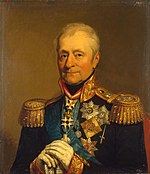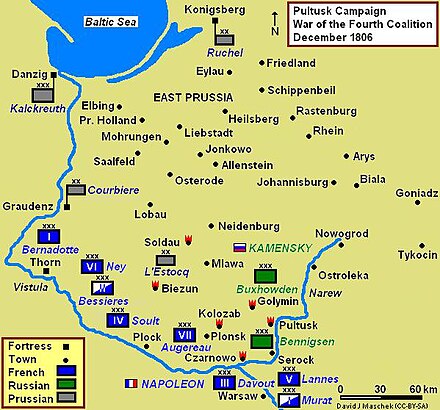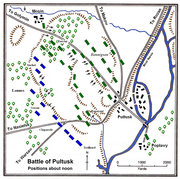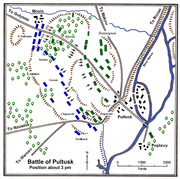Battle of Pułtusk (1806)
| Battle of Pułtusk | |||||||
|---|---|---|---|---|---|---|---|
| Part of the War of the Fourth Coalition | |||||||
 Battle of Pułtusk 1806 | |||||||
| |||||||
| Belligerents | |||||||
|
|
| ||||||
| Commanders and leaders | |||||||
|
| |||||||
| Strength | |||||||
| 25,000-27,000 soldiers[2] | 40,000-45,000 soldiers, 128 guns,[2] of which 35,000 engaged[3][4] | ||||||
| Casualties and losses | |||||||
|
unclear, see below |
unclear, see below | ||||||
The Battle of Pułtusk took place on 26 December 1806 during the War of the Fourth Coalition near Pułtusk, Poland. Despite their strong numerical superiority and artillery, the Russians suffered the French attacks, before retiring the next day having suffered greater losses than the French, disorganizing their army for the rest of the year.
Background
Strategic context
After defeating the

The Russian army was under the overall command of
When this was reported to Napoleon, he assumed the Russians were in full retreat. He ordered the forces under Marshal
Kamensky reversed the Russian retreat, and he ordered an advance to support the troops on the River Wkra.
Weather
The weather caused severe difficulties for both sides. Mild autumn weather had lasted longer than normal.
There were also difficulties with supply. Captain Marcellin Marbot, who was serving with Augereau's Corps wrote:
It rained and snowed incessantly. Provisions became very scarce; no more wine, hardly any beer, and what there was exceedingly bad, no bread, and quarters for which we had to fight the pigs and the cows.[19]
Site
Pułtusk lies on the west bank of the River Narew with a suburb on the east bank. The road from Strzegociz crossed the river by a bridge and then ran north-west towards Gołymin. A second road from Warsaw entered the town from the south-west, and then ran along the west bank of the river towards Różan. Before it reached Pułtusk this road was joined by one from Nasielsk. Another longer route to Różan ran along the east bank. The final road was that to Markow, which ran northwards from the town. The town itself lay on low ground. To the north and west lay a plateau, narrowing to a wide ridge nearer the river. A ravine cut into the plateau near the river. A large wood lay on the north-west side of the plateau, towards the village of Mosin. Further out from the plateau more woods covered the approaches from Warsaw.[20]
Battle
Forces

Lannes commanded two infantry divisions under

Historian Francis Loraine Petre wrote that General of Division Nicolas Léonard Beker's 1,200-strong 5th Dragoon Division was also present, but did not note its composition. Petre mentioned Beker and Trelliard, but not Colbert-Chabanais.[23] Petre stated that Beker led the 5th Division.[24] Digby Smith placed Beker in charge of the 2nd Dragoon Division and listed the 3rd, 4th, 10th, 11th, 13th, and 22nd Dragoon Regiments as part of this unit. These units are identical to Grouchy's division.[21] General of Brigade Joseph Augustin Fournier Marquis de D'Aultane was the acting commander of the 3rd Division of Davout's corps. This unit was made up of two brigades. General of Brigade Claude Petit led the 2-battalion 12th Line Infantry Regiment and the 3-battalion 21st Line Infantry Regiment. General of Brigade Nicolas Hyacinthe Gautier directed the 25th and 85th Line Infantry Regiments, two battalions each. General of Division Louis Michel Antoine Sahuc led the 4th Dragoon Division, which only had one brigade present. General of Brigade Jacques Léonard Laplanche commanded the 15th and 25th Dragoon Regiments.[21][25] Fournier had 70 chasseurs à cheval, 100 dragoons, and only one artillery piece attached to his command. The rest of the corps cavalry was at Gołymin.[26]
Bennigsen commanded Ostermann-Tolstoy's 2nd Division, Sedmoratski's 6th Division, and elements of the 3rd and 4th Divisions. The 2nd Division had three infantry and one cavalry brigades.
The 6th Division also controlled three infantry and one cavalry brigades. Major General
Action
This section needs additional citations for verification. (December 2017) |

Bennigsen arrayed his forces
Marshal Lannes had orders to cross the Narew at Pułtusk with his corps. He was aware that there was a Russian force in front of him, but did not know its size. After struggling through the mud, his first troops reached the area at about 10:00 AM,[23] and drove the cossacks back onto the Russian main line. Because of the terrain, Lannes could only see the Russian advance positions on the extreme left and right with the cavalry between them.
Lannes deployed Suchet's division on his left, opposite the Mosin wood. Gazan's division covered the rest of the Russian line. The few guns were deployed on the left and in the centre.[2]
At about 11:00 AM the French right advanced against Baggovut. The Russian cossacks and cavalry were driven back and Baggovut sent forward a

At the same time as the French right attacked, on the French left Suchet's division, led by Lannes in person, attacked the position held by Barclay. The initial attack drove the Russians out of the wood, and captured the battery stationed there, but Barclay's reserve drove the French back into the wood and recaptured the guns.
The French centre had also advanced. The Russian cavalry withdrew behind the main line, exposing the French to artillery fire from the Russian batteries.
By about 2 p.m.[32] the French position looked dangerous. The Russian left had held, the French centre was suffering from the artillery fire, and on the right increasing pressure was beginning to force Suchet's men out of the wood. A French retreat looked a distinct possibility when unexpected reinforcements arrived.

The 3rd Division of Davout's 3rd Corps, temporarily commanded by his
Seeing this force approach, Bennigsen wheeled back his main line to face the wood, thus reducing the artillery fire directed at Lannes's units. Barclay, finding Fournier attacking his right flank, fell back to the right of the main Russian line. Bennigsen reinforced him with two infantry regiments and some cavalry, and directed an artillery battery to fire on the wood. Thus reinforced Barclay attacked the wood. The French were driven out, and Fournier's right flank exposed. This was attacked by twenty squadrons of Russian cavalry, but the 85th French Infantry Regiment formed squares and by a steady fire drove the cavalry off. At about 8:00 PM the combat died away, and Fournier retired to the edge of the woods.[33]
The arrival of Fournier's division also had an effect on the French right wing. With the switch of much of the Russian artillery to support Barclay de Tolly, the French were able to use their own guns to support a fresh attack at about 2:00 PM[34] on Baggovut by the brigades of Claparède and Vedel, supported by Gazan on their left. Baggovut's men were driven back over the ravine in their rear, and their guns captured. Ostermann-Tolstoy established a battery to Barclay's right and reinforced by five battalions he attacked. After a desperate fight the French were thrown back and the guns recaptured. The French right and centre fell back to their start positions as night fell.
During the night, Bennigsen decided to retire, and did so the next day, 27 December, using the longer road to Różan along the east bank of the Narew. From there he continued his retreat to Ostrołęka. Fournier's division also moved off to rejoin the 3rd Corps at Golymin. Lannes was in no position to pursue the Russians, and occupied Pułtusk on 28 December.
Analysis
Losses on both sides are disputed. Lannes claimed the Russians lost 2,000 killed, 3,000 wounded and 1,800 prisoners, a total of 6,800; Sir Robert Wilson, British liaison officer with the Russian army, claimed the Russians lost less than 5,000 men. Lannes undercounted and only admitted to 700 French killed and 1,500 wounded; Russian authorities said the French losses were 7,000 killed and wounded and 70 prisoners. Given that the French were attacking and exposed to artillery fire, a total for them of 7,000 killed, wounded and prisoners does not seem unreasonable, and a total of 5,000 casualties for the Russians seems a good estimate. Petre quotes the various authorities.[35] Another authority gives French losses as five generals and 140 officers killed or wounded, 3,200 soldiers dead or wounded, and 700 captured. Russian losses are stated as 3,500 total, including 1,500 men and 12 guns captured. On the French side, Lannes, Bonnard, Claparède and Vedel were all wounded.[21]
Bennigsen claimed a victory. The consensus seems to be[36] that having decided to fight, in defiance of his orders he could have better disposed his forces, taken the offensive and destroyed Lannes's corps before Fournier came up. Bennigsen said he thought he was facing 60,000 French under Napoleon in person, which may explain his defensive stance. Bennigsen also complained that Buxhoeveden did not support him, but that officer was obeying his orders to retire.
Lannes, on the other hand, was following his orders, and the result was to find himself facing a superior force in a good defensive position. Napoleon's orders had not allowed for this, and unaware of the odds against him, Lannes attacked. If Fournier had not used his initiative and marched to the sound of the guns, the result may have been very different.
Aftermath
At the
The Russian 5th and 7th Divisions retired towards the main body of the army at Różan. Bennigsen's forces fell back to Nowogród on the River Narew, uniting on 1 January 1807 with the forces under Buxhoeveden. On 28 December, Napoleon stopped his advance and, having lost contact with the Russian army, decided to go into winter quarters. His troops were exhausted and discontented, and the supply situation was in great disorder.[37]
The break in hostilities did not last long. Soon afterward, Bennigsen was appointed army commander and he launched an unexpected winter offensive into East Prussia. Aimed at the French strategic left flank, the Russian blow was blunted at the Battle of Mohrungen on 25 January 1807. Napoleon immediately counterattacked, trying to cut the Russian communications line that ran to the northeast. The French caught up with the Russians on 7 and 8 February 1807 and the dreadful Battle of Eylau was fought.
Popular culture
The battle is included in Leo Tolstoy's War and Peace.[38]
Notes
- ^ a b Bodart 1908, p. 377.
- ^ a b c d Petre 2001, p. 96.
- ^ Chandler 2009, p. 521.
- ^ Roberts 2016.
- ^ Petre 2001, p. 38.
- ^ Petre 2001, p. 70.
- ^ Petre 2001, p. 39.
- ^ a b Petre 2001, p. 40.
- ^ Petre 2001, p. 73.
- ^ Petre 2001, p. 76.
- ^ Petre 2001, p. 77.
- ^ Petre 2001, pp. 79–82.
- ^ Petre 2001, pp. 77–78.
- ^ Petre 2001, pp. 84–85.
- ^ Petre 2001, p. 89.
- ^ Petre 2001, p. 354.
- ^ Napoleon 1860.
- ^ Petre 2001, p. 93.
- ^ Marbot 2005, 1:xxvii.
- ^ Petre 2001, pp. 90–91.
- ^ a b c d e f Smith 1998, p. 235.
- ^ Chandler 2005, p. 36.
- ^ a b Petre 2001, p. 95.
- ^ Petre 2001, p. 177.
- ^ Chandler 2005, p. 35.
- ^ Petre 2001, p. 100.
- ^ a b Millar 2004.
- ^ Petre 2001, pp. 90–107.
- ^ Chandler 1995, p. 521.
- ^ Chandler 1999, p. 439.
- ^ Petre 2001, p. 91.
- ^ Petre 2001, p. 99.
- ^ Petre 2001, p. 101.
- ^ Petre 2001, p. 102.
- ^ Petre 2001, p. 103.
- ^ Petre 2001, pp. 104–105.
- ^ Petre 2001, p. 117.
- ^ Tolstoy 1949, p. 221.
References
- Bodart, Gaston (1908). Militär-historisches Kriegs-Lexikon (1618-1905) (in German). Retrieved 22 June 2021.
- ISBN 0-02-523660-1.
- Chandler, David (2009). The Campaigns of Napoleon. Simon & Schuster.
- Chandler, David (1999). Dictionary of the Napoleonic Wars. Ware: Wordsworth Editions Ltd. ISBN 1-84022-203-4.
- Chandler, David (2005). Jena 1806: Napoleon destroys Prussia. Westport, Conn.: Praeger Publishers. ISBN 0-275-98612-8.
- ISBN 1-4179-0855-6. Translated by A J Butler. References are to book and chapter. Also available in English translation online, see external links below.
- Millar, Stephen (2004). "Russian-Prussian Order-of-Battle at Eylau: 8 February 1807: The Left Wing". Archived from the original on 27 October 2004.
- Napoleon (1860). Correspondance de Napoleon Ier.
- ISBN 1-85367-441-9. Petre used many first hand French sources, German histories and documents from the French Army archives. However as he spoke no Russian he was not able to use any Russian sources.
- Roberts, A. (2016). Napoleon the Great. London: Penguin UK. ISBN 9780241294666.
- ISBN 1-85367-276-9.
- Tolstoy, Leo (1949). War and Peace. Garden City: International Collectors Library.
Further reading
- Stolarski, P. (1997). Elyau. Miniature Wargames Magazine 3/1997.
External links
- Memoirs of Marbot translated into English
- Napoleon Miniatures Wargame Society of Toronto
 Media related to Battle of Pułtusk at Wikimedia Commons
Media related to Battle of Pułtusk at Wikimedia Commons
| Preceded by Battle of Golymin |
Napoleonic Wars Battle of Pułtusk (1806) |
Succeeded by Battle of Mohrungen |

